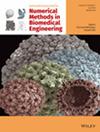Mechanobiological Model of Endochondral Ossification and Trabecular Bone Modeling
Abstract
This work presents the integration of mechanobiological models to predict the natural evolution of bone modeling and remodeling processes to obtain the architecture of trabecular bone from the embryonic stage in mammalians. Bone modeling is simulated in two and three dimensions using a reaction–diffusion mechanism with parameters in Turing space. This approach involves the interaction of two molecular factors (VEGF and MMP13) released by hypertrophic chondrocytes that diffuse and interact within a hyaline cartilage matrix. The bone remodeling process follows the model proposed by Komarova et al. employing a set of differential equations to describe autocrine and paracrine interactions between osteoblastic and osteoclastic cells, determining cellular dynamics and changes in bone mass. Bidimensional and tridimensional results for a cartilage portion predict morphological self-organization parameters between VEGF and MMP13, similar to those present in the architecture of immature trabecular bone. These findings suggest that the dynamic properties of molecular factors play a crucial role in the temporal self-organization of bone mineralization metabolism, leading to a heterogeneous trabecular architecture characteristic of primary trabecular bone. Through the three-dimensional bone remodeling model performed on the surface of trabeculae, it is established that equilibrium in population dynamics leads to asynchronous homeostatic remodeling for bone renewal, culminating in the formation of secondary trabecular bone.


 求助内容:
求助内容: 应助结果提醒方式:
应助结果提醒方式:


